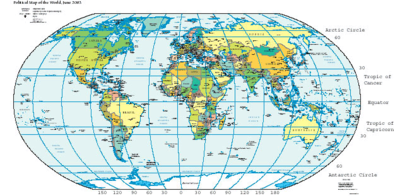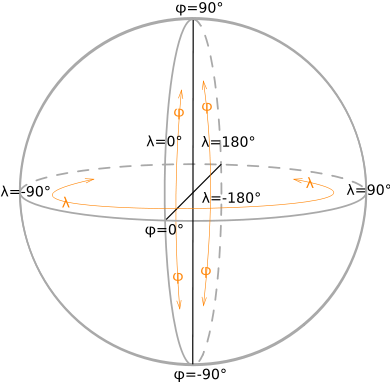Sistim koordinat géografi: Béda antarrépisi
Konten dihapus Konten ditambahkan
Addbot (obrolan | kontribusi) m Bot: Migrating 114 interwiki links, now provided by Wikidata on d:q22664 (translate me) |
m Ngarapihkeun éjahan, replaced: eo → éo |
||
| Baris ka-7: | Baris ka-7: | ||
*[[latitude]] (Lat.) is the angle between any point and the [[equator]]. Lines of constant latitude are called [[circle of latitude|parallel]]s. They trace circles on the surface of Earth, with each [[Geographical pole|pole]] being 90 degrees ([[north pole]] 90° N; [[south pole]] 90° S). The equator, an imaginary line that divides the globe into the Northern and Southern Hemispheres, is located at 0° latitude. |
*[[latitude]] (Lat.) is the angle between any point and the [[equator]]. Lines of constant latitude are called [[circle of latitude|parallel]]s. They trace circles on the surface of Earth, with each [[Geographical pole|pole]] being 90 degrees ([[north pole]] 90° N; [[south pole]] 90° S). The equator, an imaginary line that divides the globe into the Northern and Southern Hemispheres, is located at 0° latitude. |
||
*[[longitude]] (Long.) is the angle east or west of an arbitrary point on Earth: The [[Royal Observatory, Greenwich]] ([[United Kingdom|UK]]) is the international zero-longitude point (longitude=0 degrees). The [[Antipodes|antipodal]] meridian of Greenwich is both 180°W and 180°E. Lines of constant longitude are called [[meridian (geography)|meridian]]s. The meridian passing through Greenwich is the [[Prime Meridian]]. Unlike parallels, all meridians are halves of great circles, and meridians are not parallel: they intersect at the north and south poles. |
*[[longitude]] (Long.) is the angle east or west of an arbitrary point on Earth: The [[Royal Observatory, Greenwich]] ([[United Kingdom|UK]]) is the international zero-longitude point (longitude=0 degrees). The [[Antipodes|antipodal]] meridian of Greenwich is both 180°W and 180°E. Lines of constant longitude are called [[meridian (geography)|meridian]]s. The meridian passing through Greenwich is the [[Prime Meridian]]. Unlike parallels, all meridians are halves of great circles, and meridians are not parallel: they intersect at the north and south poles. |
||
By combining these two angles, the horizontal position of any location on Earth can be specified. |
By combining these two angles, the horizontal position of any location on Earth can be specified. |
||
For example, [[Baltimore, Maryland]] (in the [[United States|USA]]) has a latitude of 39.3° North, and a longitude of 76.6° West ({{coor d|39.3|N|76.6|W|}}). So, a vector drawn from the center of Earth to a point 39.3° north of the equator and 76.6° west of Greenwich will pass through Baltimore. |
For example, [[Baltimore, Maryland]] (in the [[United States|USA]]) has a latitude of 39.3° North, and a longitude of 76.6° West ({{coor d|39.3|N|76.6|W|}}). So, a vector drawn from the center of Earth to a point 39.3° north of the equator and 76.6° west of Greenwich will pass through Baltimore. |
||
This latitude/longitude "webbing" is known as the common '''''graticule'''''. There is also a complementary '''transverse graticule''' (meaning the graticule is shifted 90°, so that the poles are on the horizontal equator), upon which all [[spherical trigonometry]] is ultimately based.--> |
This latitude/longitude "webbing" is known as the common '''''graticule'''''. There is also a complementary '''transverse graticule''' (meaning the graticule is shifted 90°, so that the poles are on the horizontal equator), upon which all [[spherical trigonometry]] is ultimately based.--> |
||
<!-- a whole separate article on "transverse graticule" is planned --> |
<!-- a whole separate article on "transverse graticule" is planned --> |
||
<!-- |
<!-- |
||
Traditionally, degrees have been divided into [[Minute of arc|minutes]] ( ′ ) and [[Arcsecond|seconds]] ( ″ ). There are several formats for degrees, all of them appearing in a Lat.-Long. order: |
Traditionally, degrees have been divided into [[Minute of arc|minutes]] ( ′ ) and [[Arcsecond|seconds]] ( ″ ). There are several formats for degrees, all of them appearing in a Lat.-Long. order: |
||
* '''DM''' Degree:Minute (49:30.0-123:30.0) |
* '''DM''' Degree:Minute (49:30.0-123:30.0) |
||
| Baris ka-24: | Baris ka-23: | ||
To change from DM or DMS to DD, Decimal degrees = whole number of degrees, plus minutes divided by 60, plus seconds divided by 3600. Decimal division is now the most common and standard. |
To change from DM or DMS to DD, Decimal degrees = whole number of degrees, plus minutes divided by 60, plus seconds divided by 3600. Decimal division is now the most common and standard. |
||
The equator is obviously an important part of this coordinate system, it represents the zeropoint of the latitude angle, and the halfway point between the poles. The equator is the [[fundamental plane]] of the geographic coordinate system. All spherical coordinate systems define such a fundamental plane. |
The equator is obviously an important part of this coordinate system, it represents the zeropoint of the latitude angle, and the halfway point between the poles. The equator is the [[fundamental plane]] of the geographic coordinate system. All spherical coordinate systems define such a fundamental plane. |
||
Latitude and Longitude values are established based on an associated [[Geodetic system]] or [[datum]] such as [[World Geodetic System|WGS 84]]. In other words, the same exact point on the earth’s surface will be expressed by different latitude and longitude values, depending on the reference datum. |
Latitude and Longitude values are established based on an associated [[Geodetic system]] or [[datum]] such as [[World Geodetic System|WGS 84]]. In other words, the same exact point on the earth’s surface will be expressed by different latitude and longitude values, depending on the reference datum. |
||
In popular GIS software, data projected in latitude/longitude is often specified via a 'Geographic Coordinate System'. For example, data in latitude/longitude with the [[datum]] as the [[North American Datum]] of 1983 is denoted by 'GCS_North_American_1983'. |
In popular GIS software, data projected in latitude/longitude is often specified via a 'Geographic Coordinate System'. For example, data in latitude/longitude with the [[datum]] as the [[North American Datum]] of 1983 is denoted by 'GCS_North_American_1983'. |
||
| Baris ka-39: | Baris ka-38: | ||
--> |
--> |
||
== Tempo ogé == |
== Tempo ogé == |
||
* [[Sistim informasi géografi]] ( |
* [[Sistim informasi géografi]] (Géographic information system, GIS) |
||
* [[Sistim posisi global]] (Global Positioning System, GPS) |
* [[Sistim posisi global]] (Global Positioning System, GPS) |
||
* [[Konvérsi koordinat géografi]] |
* [[Konvérsi koordinat géografi]] |
||
Révisi nurutkeun 27 Januari 2017 07.53
Sistim koordinat géografi digunakeun pikeun nunjukkeun lokasi di Bumi ku dua atawa tilu koordinat tina sistim koordinat bal nu dilarapkeun jeung sumbu puteran Bumi.

Diménsi kahiji jeung kadua: gurat usum jeung wanci

Tempo ogé
- Sistim informasi géografi (Géographic information system, GIS)
- Sistim posisi global (Global Positioning System, GPS)
- Konvérsi koordinat géografi
- Geocode
- Tropic of Cancer
- Tropic of Capricorn
- Great-circle distance explains how to find that quantity if one knows the two latitudes and longitudes.
- Proyéksi peta
- Sistim koordinat Universal Transverse Mercator
